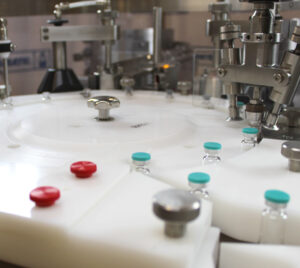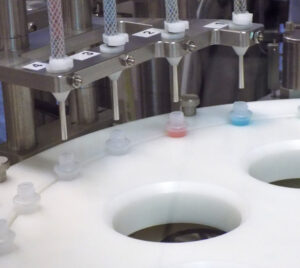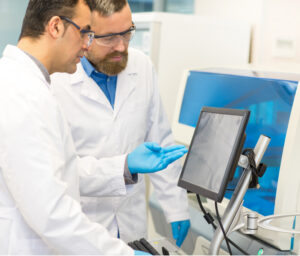In the intricate world of liquid packaging there exists layers of quality control procedures that can determine the future of any one container traveling down the conveyor. As the range of liquid filling equipment continues to advance, so does the need for speed, accuracy, and data deliverability within these types of quality control features.
 We will review a range of fill verification techniques like using sensors, flow meters, and other forms of checks in a later blog. Today, we’ll focus on one method of product inspection within liquid packaging – weigh systems.
We will review a range of fill verification techniques like using sensors, flow meters, and other forms of checks in a later blog. Today, we’ll focus on one method of product inspection within liquid packaging – weigh systems.
The procedure can be performed in two ways, Checkweigh and Net weight. Each of these processes describe a different method of weighing and verifying weights and measures for legal sale. Although these are separate processes, they are connected methods of weighing and measuring fill volumes.
We spoke with some industry experts to help us navigate these two types of weigh systems through a simple Q&A session.
Q: For a general point of clarity, please describe Checkweigh and Net weight concepts as it relates to liquid packaging?
A: A Checkweigh system is typically used for precision weigh scales using a load cell located under the turret or filling pathway. This process is performed with a high degree of accuracy weighing the liquid product while the container is still in motion. It measures both your bottle, cap, and liquid product with pinpoint accuracy.
Net weight conversely uses a two-step process. It will involve weighing the empty container prior to filling then weighing it again post filling, to obtain a total weight for real-time review. The bottle weight is then subtracted from the total weight thus providing a true net weight.
Q: What are some of the basic benefits of using these types of weigh systems?
A: These weigh systems can be complex, fairly involved and not for every type of production environment, but they are incredibly accurate forms of measurement. In a nutshell, these types of processes enhance accuracy and reduce product loss, increase product quality, helps to meet regulatory requirements, provides accurate, reliable data to better manage processes, and tracks productivity.
Q: Is Checkweigh/Net weight a relatively new process or has it been around for some time? Additionally, what are some of the intricacies and nuances one should understand when considering either type of weigh system?
A. The actual technology has been around for some time; the overall concept even longer. However, its use and specific liquid packaging applications are still somewhat recent; it’s a process that offers an amazing level of accuracy but does have some limitations. In a laboratory or true production environment where the weigh systems may be integrated into an automated Monobloc filling system, it is best suited for slow processing or sterile applications where there is the least amount of a vibratory effect.
 That is, any unnecessary or even necessary manufacturing vibratory effect could influence such a highly sensitive measuring device. But as some filling systems may have a vibratory bowl, the Project Engineer will certainly design around these specialty needs to best mitigate these unwanted influences.
That is, any unnecessary or even necessary manufacturing vibratory effect could influence such a highly sensitive measuring device. But as some filling systems may have a vibratory bowl, the Project Engineer will certainly design around these specialty needs to best mitigate these unwanted influences.
But given its highly accurate and sensitive scales, there are other factors that can also impact the weighing process outside of any obvious vibratory influence. For instance, background noise for example can contribute to vibrations which limit accuracy. Sideloads, load spikes, corrosion and contamination are additional factors that will also affect weighing accuracies.
All said the addition of either a Checkweigh or Net Weight feature to your liquid filling system can add a layer of complexity and cost not all may require nor be able to afford. Consequently, it may be used to confirm what is already known, mainly that your system is either very accurate or not at all so.
However, given your industry, regulatory needs, and overall compliance issues, you may require production data showing a high-level of accuracy and consistent dosing through your liquid filling equipment. Case in point but not exclusive, filling vaccines or different types of pharmaceuticals may require a higher-level of supportive data as well as traceability within its manufacturing.
 Q: Is it appropriate to say that checkweigh methods are preferable for a very exact and precise filling application in industries such as pharmaceutical, cosmetic, diagnostic, bio-tech, and food/beverage packaging?
Q: Is it appropriate to say that checkweigh methods are preferable for a very exact and precise filling application in industries such as pharmaceutical, cosmetic, diagnostic, bio-tech, and food/beverage packaging?
A: The Checkweigh process is a very accurate method of measuring and also measures the volume of a bottle’s contents. Load cells located underneath the container on the line, checks the bottle for weight at exact moments of travel. This allows for precise measurements to be read for micro-dose or exceedingly small fills as low as 0.25ml, 0.5ml, 1ml or 2ml fill volumes.
Q: What effect does the package substrate have on measuring and weighing fill levels?
A: Now that’s a great question. Plastic containers can be a preferred material to work with in this situation as they often have a very consistent weight – one to another when weighed empty. When glass is used there is a greater scrutiny required as glass containers have variables that do not guarantee consistency in weight. When glass containers are the substrate of choice net-weighing becomes the preferred method for measuring and accuracy. Good question.
Q: How does Checkweigh/Net weight affect a system’s filling accuracy and BPM (bottles per minute) speeds?
A: The integration of a weigh system onto a filling line can and will have an impact on accuracy but not always directly. The benefit of these systems is that they allow the operator to be aware of the variances in weight and fill levels. Depending on the integrated weigh system, they may simply alert the operator and not correct these errors automatically, or some more involved systems can be connected to the filling system and depending on data received signal the filling system to automatically make adjustments.
Ultimately, these quality control systems provide the information so that an operator can adjust accordingly. These systems can offer guidance and record reject details for later ‘big data’ needs. They will also offer confirmation of fill levels and other pertinent information on efficiencies or lack thereof, of the filling line.
 As for BPM speeds, the weighing feature does not directly impact the overall bpm. To be fair, there are many different factors that can impact a machine’s throughput, choice of weigh system relies heavily on a range of design requirements. Desired line speeds, need for a HEPA environment, accuracy requirements, projected budget, overall volume of units to be filled, and footprint limitations are all factors that can help determine your choice of weigh system.
As for BPM speeds, the weighing feature does not directly impact the overall bpm. To be fair, there are many different factors that can impact a machine’s throughput, choice of weigh system relies heavily on a range of design requirements. Desired line speeds, need for a HEPA environment, accuracy requirements, projected budget, overall volume of units to be filled, and footprint limitations are all factors that can help determine your choice of weigh system.
So, if your application requires a high-level of filling accuracy, real-time production data with traceability components, as well as reducing product loss, increases in quality, and helping meet industry regulatory and compliance needs, adding a Checkweigh or Net weight system to your manufacturing may make sense.
Specialists in Liquid Filling Systems
Good points to be remembered when considering your next filling system with possible product inspection features. FILAMATIC is a leading manufacture of liquid filling machinery, we do not manufacture weigh systems. However, we do have a variety of customers from different industries that require different types of inspection systems integrated within their liquid filling equipment, this level of consultation, experience, and vetted system partners helps us guide your liquid filling projects. For more information on semi-automatic handheld filling machines, automatic complete fill-cap-label filling lines, and fully automated Monobloc systems, please email info@filamatic.com or call 866.258.1914. We would be happy to help you with your liquid filling project.
